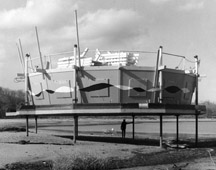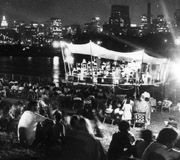Jeff Hawkins
The man who almost single-handedly revived
the handheld computer industry
by Shawn Barnett, Photos by John Harding

These days it seems like success won't leave Jeff Hawkins alone. The company he founded eight years ago, Palm Computing, just went for its initial public offering and soared to heights no one imagined. His second company, Handspring, founded in late 1998, makes a Palm-compatible computer that is so popular they've only recently made enough to meet the demand. He's being hailed in both the technology and mainstream press, and his name is on its way to becoming a household word like Bill Gates or Steve Jobs. If he has his way, in a few years he may be known not only for his work in the field of handheld computers, but for his work in brain research.
But the Hawkins success story didn't start in 1998, nor did it start in 1996 when Ed Colligan, Palm Computing's Marketing VP, showed us the original Pilot. The seeds of his success go all the way back, past the small software company that made software for the Casio Zoomer, beyond GRiD where he created the GRiDPAD, all the way back to a household garage and a shipyard in New York where he and his brothers helped his dad create all manner of floating contraptions in the mid-1960's.

"We designed boats, built boats, lived on boats; most of my family lives on boats today," said Hawkins. "My father was sort of this consummate inventor. If you've ever seen the movie of the play 'You can't take it with you' with Jason Robards, it's about this crazy house where they had a great time, but it's really crazy. That's what my upbringing was like. We did crazy things, but seemed to have a good time doing it. Never had much success, or had much money in the family, but we built all kinds of wild and crazy boating stuff.
"Part of my life was growing up in that old shipyard on the North Shore of Long Island called Jacobson. It's closed down now, but it was one of the last shipyards in that part of the country. We built this big round boat there. It was an air cushion craft. It had a fabric skirt, it was round--sixteen sided--and it was open on the bottom, so it wasn't complete, and the boat floated on this. It didn't force air out--it wasn't a hovercraft--it just sort of floated on this bubble. And it was actually, believe it or not, powered by a vacuum cleaner fan to lift up this 50 ton craft. It didn't have to force any volume of air out; it was a displacement boat. It only displaced a couple feet of water across a large area. The official name of the boat was Sea Space, but we sometimes called it the bubble monster."

The Sea Space project kept him and his family busy for about ten years, even after they sold the platform to the Waterways Orchestra. Because any beach below the high water mark was public property, they would float the Sea Space up to just about any beach, drop down the built-in legs, extend the boarding plank, and they would have a home on the beach. In the case of the Waterways Orchestra, they would give a concert. Every few nights in a given season, Jeff and his brothers would man the boat for the orchestra as they toured, giving concerts in places like Manhattan, Long Island, Connecticut, and Albany. "It was an interesting experience."
"I tell that story because all those experiences, you know learning to use shop tools, learning to use fiberglass and screws and stuff, is actually very useful in building little computers," said Hawkins. "Not many people in my business can get involved in as many aspects of product design as I do."
His father, Robert Hawkins, and one of his brothers, went on to England where they continued their fascination for building floating structures, building a floating hotel, parking garage, and even a floating housing community. One of his other brothers is currently sailing around the world with his wife, and Hawkins still has boating in his blood, taking his family sailing on weekends.
So young Hawkins was introduced to the creative process early.
It was in High School that Jeff's interest in Biophysics first blossomed. He liked math, physics, and other sciences, and was very involved in music, as well as building and racing sailing dinghies. "I received a reasonable number of academic awards," says Hawkins, "but my favorite was a semi-joke. The science and math teachers got together and made up an award for me called the 'Biophysics Research Associate' award, or 'BRA.' It was delivered with a set of puns about providing uplifting support, forward thinking, etc. I doubt they could get away with that today."
So with obvious interest in Biophysics and other sciences, he had some choices to make when it came to a college major. "I was going to do engineering because everyone else in my family had done that. I was also interested in alternative energy. And my father said, 'You know, why don't you look into this microelectronics stuff, that looks interesting.'"
He clearly followed his father's advice, graduating from Cornell University in 1979 with a BSEE (Bachelor of Science, Electronic Engineering). But that would not be the end of his interest in other sciences, particularly involving the brain and ultimately the study of thought. After a few years at Intel, where he taught courses on microprocessor design and trained field applications engineers, he left for GRiD Systems in 1982. Intel promised only slow advancement, and the atmosphere of GRiD appeared to offer Jeff more room for growth and influence.
One of the first things Jeff created was GRiDTask, a high-level programming language optimized for creating applications on GRiD's laptops. "It was what would today be called a 'RAD,' or Rapid Application Development language," said Geoff Walker, who worked at GRiD at the time, and is currently Director of Program Management at Handspring. Walker's group was creating simple custom software to enhance the computers' value. "Jeff's GRiDTask language was an essential element of this in that it allowed us to create simple applications very quickly."
GRiD was a pioneer in mobile computing, and many of the technologies present in notebooks and tablets today would not exist were it not for GRiD. Indeed, a good deal of the technology you have in your handheld computer today, be it a Palm or other device, owes its existence to GRiD and what happened next in the Hawkins story, especially text entry technology: Jeff left GRiD and went back to school. Apparently while mulling over how humans recognize patterns, like speech and text, so he could program a computer to do the same, he got inspired to learn more. He delved into neuroscience, theoretical neuroscience in particular.
"At the time it seemed as though he was leaving the company," says Walker. "But I think there was some understanding between him and top management that he was welcome back at any time because his creative value was obvious."
"I just got totally enamored with the problem of understanding how brains work," said Hawkins. "There's all this data about brains, all this factual knowledge about neurobiology--but there's almost no theory there. There's no real concrete theory that pulls it all together. It's one of the biggest mysteries in science, and very few people realize that. The whole thing is missing this conceptual 'Aha!'"
His goal was to answer the questions: "What does it mean for a brain, or for a system like a brain, to understand its environment? What is a reductionist approach to understanding language, vision, and hearing? And what are the mathematical concepts underlying that?"
In an interview with MIT's Technology Review, Hawkins talks about his theories of intelligence relating to autoassociative memory. "I think that intelligence is an ability of the organism to make successful predictions about its input," says Hawkins. "Intelligence is an internal measure of sensory prediction, not an external measure of behavior. When you look at my face, your eyes don't just go randomly around. They look at very specific things. Typically they will look from eye to eye to nose to mouth. What your brain is doing during this process is saying, essentially: I see a pattern here that might be a face, and this might be an eye. And if I see an eye here, there should be another eye over there. It's expecting a certain neural firing pattern at that instant. If you were to look at a face, and see a nose where an eye should be, then you'd know immediately that something was amiss.... In a nutshell, intelligence is the ability of a system to make these low-level predictions about its input patterns. The more complex patterns you can predict over a longer time, the more you understand your environment and the more intelligent you are." (See the whole interview by following the link at the end of the story.)
Hawkins did all this study at Berkeley from 1986 to 1987, where he wrote his Ph.D. thesis proposal, and also wrote a pattern classifier program based on his theories of autoassociative memories. His thesis proposal was essentially rejected, but the pattern classifier was patented and went to work as a hand-printed-character recognizer, the predecessor to the recognizer engine running on today's Palm OS computers. Though the head of the BioPhysics department thought it was a good one, the thesis proposal was rejected for no other reason than that no professors at Berkeley were doing that kind of work, and he had to work for a professor, so he was out of luck.
Thus rebuffed, Hawkins asked himself a new question: "What am I going to do with all this knowledge? Here I am a young guy, I decided I wasn't going to pursue an academic career, it was just impossible. It was like, painful: going and being a graduate student after having a real career." So he went back to GRiD, got back into the computer business, with a short-term goal of putting food on the table for his family, and a long-term goal "to become famous enough and wealthy enough to really promote and sponsor significant research in neurobiology and theoretical neurobiology."
Go to part 2 of 3
|









